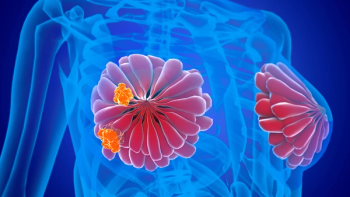
T-DM1 Further Improves DFS and OS vs Trastuzumab in HER2-Positive Early Breast Cancer
T-DM1 reduced risk of invasive disease events and death compared with trastuzumab in HER2-positive early breast cancer with residual invasive disease after neoadjuvant therapy.
Adjuvant trastuzumab emtansine (Kadcyla; T-DM1) showed higher rates of invasive-disease-free survival and overall survival as compared to trastuzumab (Herceptin) alone for patients with HER2-positive early breast cancer with residual invasive disease after neoadjuvant therapy, as demonstrated in results from the KATHERINE trial (NCT01772472).1
“This prespecified long-term follow-up analysis provides additional support for the neoadjuvant therapy paradigm by showing that adjuvant T-DM1 also provided a significant improvement in overall survival and no evidence of long-term safety issues,” wrote KATHERINE investigators in The New England Journal of Medicine.
Patients enrolled in the phase 3, open-label trial continued to see an improvement in invasive disease-free survival with T-DM1 vs trastuzumab at a median follow-up of 8.4 years (unstratified HR = 0.54; 95% CI, 0.44-0.66). Particularly, 19.7% of patients in the T-DM1 group and 32.2% of patients in the trastuzumab group experienced invasive disease events or death.
Seven-year invasive disease-free survival was achieved in 80.8% of patients treated with T-DM1 and 67.1% of patients on trastuzumab (difference, 13.7 percentage points).
The trial included patients with HER2-positive early breast cancer who had received neoadjuvant treatment, which included a taxane-based chemotherapy and/or trastuzumab, and had residual invasive cancer in the breast or resected axillary nodes. Patients were randomly assigned to receive either T-DM1 (n = 743) or trastuzumab (n = 743). Patients were stratified by clinical stage, hormone-receptor status, preoperative HER2-directed therapy, and pathological nodal status after neoadjuvant therapy.
T-DM1 significantly reduced the risk for death compared with trastuzumab (unstratified HR = 0.66; 95% CI, 0.51-0.87; P = .003). Seven-year overall survival for the T-DM1 and trastuzumab groups were 89.1% and 84.4%, respectively (difference, 4.7 percentage points). As of the trial’s cutoff date of October 5, 2023, 70.1% of patients assigned T-DM1 and 62.0% of patients assigned trastuzumab were alive and still in the trial.
Deaths occurred in 89 patients (12.0%) in the T-DM1 group and 126 patients (17.0%) in the trastuzumab group. Of these deaths, 70 (79%) and 108 (86%) patients, respectively, died from breast cancer.
Adverse events (AEs) grade 3 or higher occurred in 26.1% of patients treated with T-DM1 and 15.7% of patients treated with trastuzumab. Serious AEs occurred in 12.7% and 8.1% of patients, respectively.
Post-treatment AEs were less common for both groups but still more prevalent in the T-DM1 group, with 3.2% and 1.7% of patients assigned T-DM1 and trastuzumab, respectively, experiencing AEs of any grade during this period.
Abnormal results of investigations (e.g., laboratory studies of blood camples) were the most common adverse event, followed by cardiac disorders and nervous system disorders. Of patients treated with T-DM1, 9 experienced abnormal results of investigations, 5 experienced cardiac disorders, and 4 experienced nervous system disorders. Five cases each of abnormal results of investigations and cardiac disorders were present in the trastuzumab group, with no nervous system disorders occurring in this group.
Seven-year invasive-disease-free survival and seven-year overall survival rates in the immunohistochemistry (IHC) 2+ subgroup were 72.4% and 83.3% on T-DM1.
“These findings warrant evaluation of additional or alternative therapies to improve outcomes for these patients, including those who had initially presented with inoperable disease, those with positive axillary nodes after neoadjuvant therapy, and those with both IHC 2+ and ISH-amplified disease,” said researchers.
Discontinuation of trial enrollment due to an invasive disease event or death occurred in 105 patients (14.1%) in the T-DM1 group and 159 patients (21.4%) in the trastuzumab group. Additionally, prior discontinuation occurred in 117 patients (15.7%) and 123 patients (16.6%), respectively.
Reference:
Geyer CE Jr, Untch M, Huang CS, et al. Survival with Trastuzumab Emtansine in Residual HER2-Positive Breast Cancer. N Engl J Med. 2025;392(3):249-257. doi:10.1056/NEJMoa2406070
Newsletter
Knowledge is power. Don’t miss the most recent breakthroughs in cancer care.




















































































